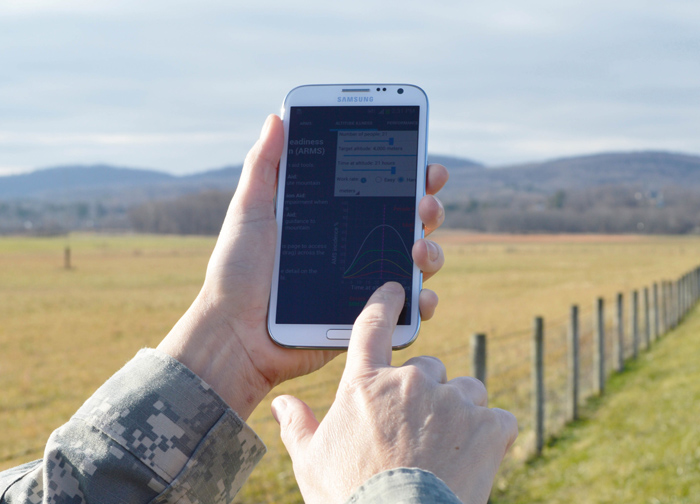Altitude App Prepped for Nett Warrior

The Medical Support Systems Project Management Office, in support of the U.S. Army Medical Materiel Development Activity, is spearheading efforts to add the Altitude Readiness Management System application, known as ARMS, to Nett Warrior, making it the first externally-developed app to be added to the situational awareness and mission command system. Thanks in part to work by MSS PMO, mission planners will have the power of more than 20 years' worth of statistical research on acute mountain sickness (AMS) at their fingertips.
ARMS is a decision-aid application designed to assist commanders with planning operations in high altitude environments. ARMS, a joint project with the U.S. Army Research Institute on Environmental Medicine and the Massachusetts Institute of Technology Lincoln Laboratory, contains three separate tools designed to assist commanders with planning effective missions at high altitudes. These are an altitude decision illness aid that estimates the risks of AMS; a work performance decision aid that estimates performance impairment when operating at high altitudes; and an acclimatization decision aid that provides acclimatization guidance to mitigate the risk of AMS.
For an application to be added to the suite of tools available on Nett Warrior, it must first undergo a rigorous testing and validation process. MSS PMO is currently directing that process for ARMS to ensure it is a suitable fit for the Nett Warrior system in regard to both form and function.
"We are the connection between USARIEM and Nett Warrior, the liaison in a way," said Alan Harner, product manager with MSS PMO. "We get involved, because they have these products that would work great in the field but need to go through that ruggedize process."
Nobody knows "ruggedize" better than 1st Sgt. Nathaniel Chipman, First Sergeant at the Army Mountain Warfare School in Jericho, Vermont. MSS PMO is working closely with AMWS to get feedback on ARMS in a user environment.
"[We] test it at the user level with not only the instructors here at the school house, but also the students that we have come through here," said Chipman.
Usability and durability are the primary focus with AMWS testing. For example, recent testing at AMWS identified sticky slide bars for data entry. According to Harner, MSS is working to address that issue.
In July 2014, Chipman took the ARMS app with him to Mt. McKinley, Alaska, where its accuracy was tested in an unofficial trial at high elevations. Each day Chipman and his eight-man team plugged in ascent information for the next day's climb into the ARMS app on a Samsung Note II, the current end-user device for Nett Warrior.
"The app would tell us that 'some of you guys are going to have mild cases of AMS,' which was pretty true," said Chipman. "So the data we collected out of it was spot-on to what the actual reality was for the next day."
While Mt. McKinley extends over 20,000 feet, the statistical data behind ARMS currently limits the app's effectiveness up to 14,000 feet. According to Chipman, the ARMS told them exactly what they needed to know up to that altitude.
Before ARMS can be added to Nett Warrior, MSS PMO must ensure the app is interoperable with the Nett Warrior system. To accomplish this, MSS PMO has scheduled ARMS for 'Certification of Networthiness' testing, as well as integration testing to ensure that it does not interfere with other Nett Warrior applications. Additionally, the decision-aid application received a green light in an independent verification and validation process completed in September by a separate MIT Lincoln Laboratory group.
Accessibility is another key consideration in the testing and evaluation process. According to Harner, the ARMS app is a standalone tool. Once the app is installed on the end-user device, no further connectivity to the Nett Warrior system is required.
"No internet access is required to operate it," said Harner.
The power behind its operating independence is based on more than 20 years of predictive modeling and an idea that originated from lectures on compression sickness. Inspired by diving hyperbaric tables developed at Duke University, the Thermal and Mountain Medicine Division team at USARIEM, led by Dr. Stephen Muza, looked at high-altitude data available from USARIEM studies as far back as 1991 to create predictive models for altitude sickness.
"In total, we had done 29 human-use studies, and we have well over 600 subjects in our database, and it's subsets of that data that we used," said Muza. "Those predictive models were originally designed for use as tables in print publications, which operational leaders could then use to determine the effects of altitude sickness."
USARIEM later transformed the tables into an interactive online tool that MIT-Lincoln Labs subsequently converted into a mobile application.
The current platform allows the predictive model to be easily updated as more data becomes available. According to Muza, USARIEM plans to update the equation behind the altitude illness decision aid based on data from studies done in 2012 and 2013. Harner also hopes to add different variables to the equation in the future, such as the use of altitude sickness medicines like Diamox.
While ARMS may prove useful in existing operations ' altitudes in Afghanistan reach as high as 24,580 feet ' its potential value is not limited only to the current theater of operations. As Muza notes, primary security concerns for the United States going forward will likely continue to come from non-traditional adversaries who fight and shelter in mountainous areas and jungles.
"Outside of Afghanistan, that is virtually every continent except Australia," says Muza.
Fortunately, the U.S. Army is a global-based organization and decision-aid tools like ARMS continue to make that mission easier.
"Anything that helps us move forward ... that will arm us to make a more informed decision ... it's going to be a good thing," said Chipman.
MSS PMO estimates the ARMS decision aid will be available on Nett Warrior for operational use as early as fiscal year 2015. A U.S. patent is pending.














